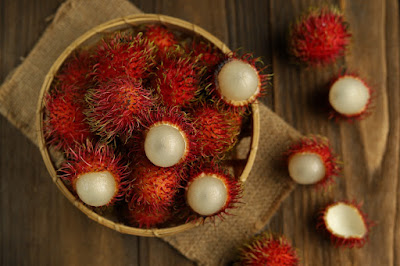Title: Cultivating Rambutan: A Tropical Delight in Kerala
Introduction: Rambutan, a tropical fruit tree renowned for its vibrant colors and
exotic taste, has found a new home in the lush landscapes of Kerala, India.
Originating from South East Asian region, this medium-sized tree has captured the attention of farmers and fruit enthusiasts alike, leading to a flourishing cultivation. In recent years, Kerala has seen a remarkable
expansion in Rambutan cultivation. With plantings spreading across vast acres of
fertile land, the state has embraced this tropical fruit with open arms.Rambutan grows well in warm tropical climate. The favorable climate, characterized by humid conditions and well-distributed rainfall, provides an ideal environment for Rambutan cultivation. Lands prone to water logging are not good for growing rambutan, slightly sloped lands are ideal. Budding is the best method for producing high-quality rambutan planting materials. If managed well, budlings produce fruits after 2 or 3 years with optimum production occurring after 6 or 8 years.
Characteristics of Rambutan: Rambutan trees can reach heights of 10-12 meters and bears numerous clusters each having 15-20 oval-shaped or round fruits with a single seed nestled inside. Each fruit, weighing around 35-50 grams, boasts vibrant hues of red or yellow and can be retained on the tree after ripening for a period of 15-20 days.
Scientific Farming Practices: Successful Rambutan cultivation relies on scientific
farming practices. From meticulous pit preparation to precise planting techniques, systematic trimming and pruning and optimal manuring, every step plays a crucial role in maximizing yield and profitability. Special care is required at each stage of the cultivation process to ensure healthy growth and abundant harvest.
Flowering Cycle and Care: The flowering cycle of Rambutan typically begins
between January and April. To stimulate floral bud formation, a brief dry spell is
necessary. Mature plants require a 2-3 weeks drought phase followed by irrigation to induce flowering. Regular watering is essential to prevent flower and fruit drop,especially during periods of excessive temperatures. For rambutan trees aged 3 to 8years, applying muriate of potash at a rate of 250g to 800g is advised prior to drought phase. Micronutrient spray at 1g/l post-flowering can compensate for micronutrient deficiencies. In case of excessive flower drop, potassium nitrate spray at 3g/l can help stimulate flower production on the same panicle.
Research and Development: In Kerala, pioneering efforts in Rambutan cultivation
were initiated by Homegrown nursery and farms. Homegrown boasts a dedicated
R&D team, tirelessly engaged in research for the past 25 years. They have explored innovative methodologies of commercial cultivation in other South East Asian countries to enhance farming practices, leading to increased productivity and sustainability in the agricultural sector.
Conclusion: As Rambutan cultivation continues to thrive in Kerala, it stands as a
testament to the region’s adaptability and agricultural prowess. With its delicious
fruits and economic potential, Rambutan has become a symbol of prosperity in
God’s Own Country. Through ongoing research and commitment to best practices, Kerala’s farmers are poised to unlock even greater success in the cultivation of this tropical delight.









Comments
Post a Comment